Captain Kidd
Joseph Smith's hero?
"[Joseph] claimed to know where Captain Kidd
had hidden money in Palmyra.”
-Piletus B. Spear-
"[Joseph] would tell his gaping audience where
the treasures of Kidd and others lay concealed"
-J. H. Kennedy
"He claimed he saw writing cut on the rocks in an unknown language telling where Kidd buried it, and he translated it through his peepstone."
-W. R. Hine-
"He could reveal, full too well, the place where stolen property
or wandering flocks could be found. Caskets of gold stored
away by the Spaniards, or by his hero, the redoubtable
Captain Kidd..."
-Anna Ruth Eaton-

William Kidd
c. 1654 - 23 May 1701
Wayne Sentinel
16 February, 1825
The February 16, 1825 issue of Palmyra’s Wayne Sentinel reprinted a piece from the Windsor (Vermont) Journal that read:
Money digging. –We are sorry to observe even in this enlightened age, so prevalent a disposition to credit the accounts of the Marvellous. Even the frightful stories of money being hid under the surface of the earth, and enchanted by the Devil or Robert Kidd, are received by many of our fellow citizens as truths.”


Rochester Gem
15 May 1830
Within a month-and-a-half of the Book of Mormon’s first public appearance in Grandin’s bookstore in Palmyra, an article appeared in the Rochester Gem describing an attempt by one of the Smith sons at finding Kidd’s treasure.
“If we remember aright, it was in the year 1815, that a family of Smiths moved into these parts, and took up their abode in a miserable hut on the east bank of the river, now near the late David K. Carter's tavern. They had a wonderful son, of about 18 years of age, who, on a certain day, as they said, while in the road, discovered a round stone of the size of a man's fist, the which when he first saw it, presented to him on the one side, all the dazzling splendor of the sun in full blaze -- and on the other, the clearness of the moon. He fell down insensible at the sight, and while in the trance produced by the sudden and awful discovery, it was communicated to him that he was to become an oracle -- and the keys of mystery were put into his hands, and he saw the unsealing of the book of fate. He told his tale for money. Numbers flocked to him to test his skill, and the first question among a certain class was, if there was any of Kidd's money hid in these parts in the earth.”
“The oracle, after adjusting the stone in his hat, and looking in upon it sometime, pronounced that there was. The question of where, being decided upon, there forthwith emerged a set, armed with "pick-axe, hoe and spade," out into the mountains, to dislodge the treasure. We shall mention but one man of the money-diggers. His name was Northrop. He was a man so unlike anything of refined human kind, that he might well be called a demi-devil [sent] forth upon the world to baffle the elements of despair, and wrestle with fate. As you will suppose, he was an enemy to all fear. Northrop and his men sallied out upon the hills east of the river, and commenced digging -- the night was chosen for operation -- already had two nights been spent in digging, and the third commenced upon, when Northrop with his pick-axe struck the chest! The effect was powerful, and contrary to an explicit rule laid down by himself he exclaimed, ‘d----n me, I've found it!’”
“The charm was broken! -- the scream of demons, -- the chattering of spirits -- and hissing of serpents rent the air, and the treasure moved! The oracle was again consulted, who said that it had removed to the Deep Hollow.
NOTE: It is not clear whether the article is referring to Joseph Smith, Jr. or one of this older brothers. Alvin was born in 1798 and Hyrum was born in 1800.
E. D. Howe
1834
In his 1834 book Mormonism Unvailed, E. D. Howe stated that:
“All who became intimate with them [the Smiths] during this period, unite in representing the general old character of old Joseph and his wife, the parents of the pretended Prophet, as lazy, indolent, ignorant, and superstitious –having a firm belief in ghosts and witches; the telling of fortunes; pretending to believe that the earth was filled with hidden treasures, buried there by Kid[d] or the Spaniards.”

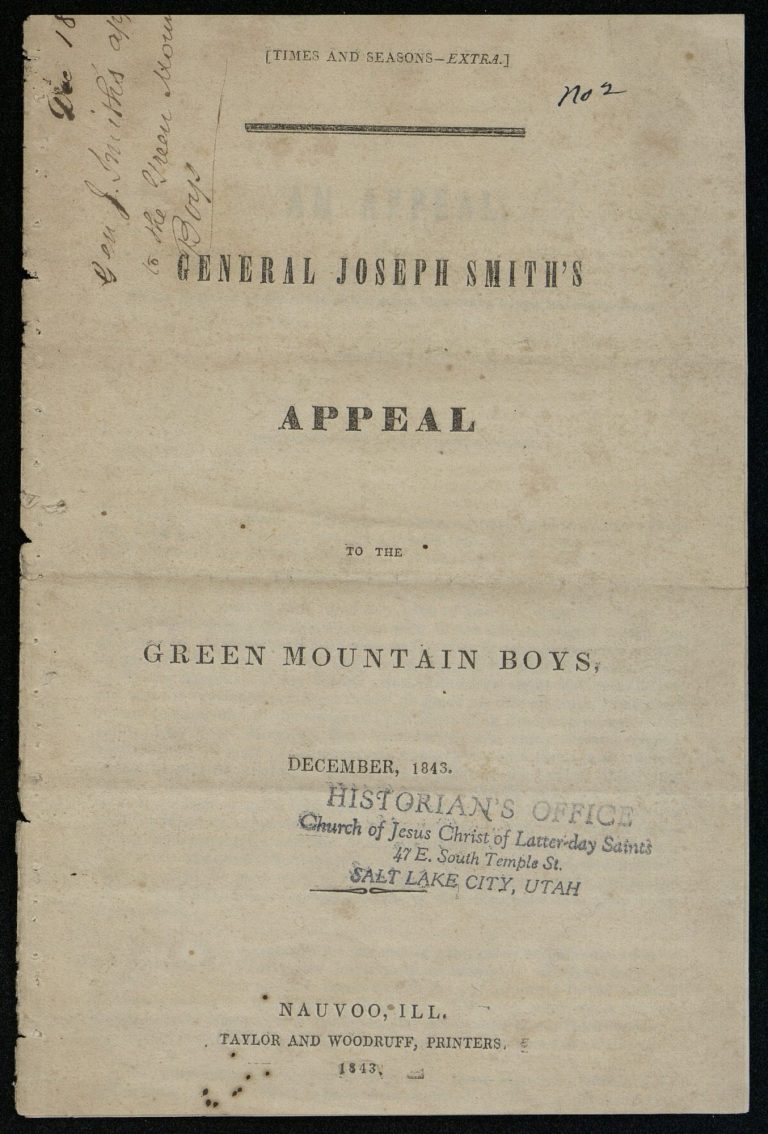
Wayne General Joseph Smith's Appeal to the Green Mountain Boys
December (November) 1843
In 1843, a pamphlet was sent out titled General Joseph Smith’s Appeal to the Green Mountain Boys. The Green Mountain Boys were formed in 1770 by settlers in present-day Vermont wishing to protect their land holding from claim by New York. The Appeal evoked an immediate response from unidentified parties in Strafford, Orange County, Vermont. On 15 February 1844 those claiming familiarity with the Smiths wrote to Thomas Sharp.
[General Joseph Smith’s Appeal to the Green Mountain Boys, December 1843]
Green Mountain Boys
15 February 1844
On 15 February 1844 those claiming familiarity with the Smiths wrote to Thomas Sharp.
“How much wisdom, prudence and virtue, our presidents[,] governors, and rulers will obtain by your appeal to <us> we leave for time to say, but one thing, they will readily discover, your eagerness for discord and civil commotions, your diabolical and treasonable object. . . . As for ourselves we believe you stand in the same position as the pirate does, and it has been your cry from first to last, but we have no sympathy for you but say to you remember Haman—If you studied piracy while digging for the money your Father pretended old Bob Kidd <had> buried, you should also have studied the fate of pirates. . . .
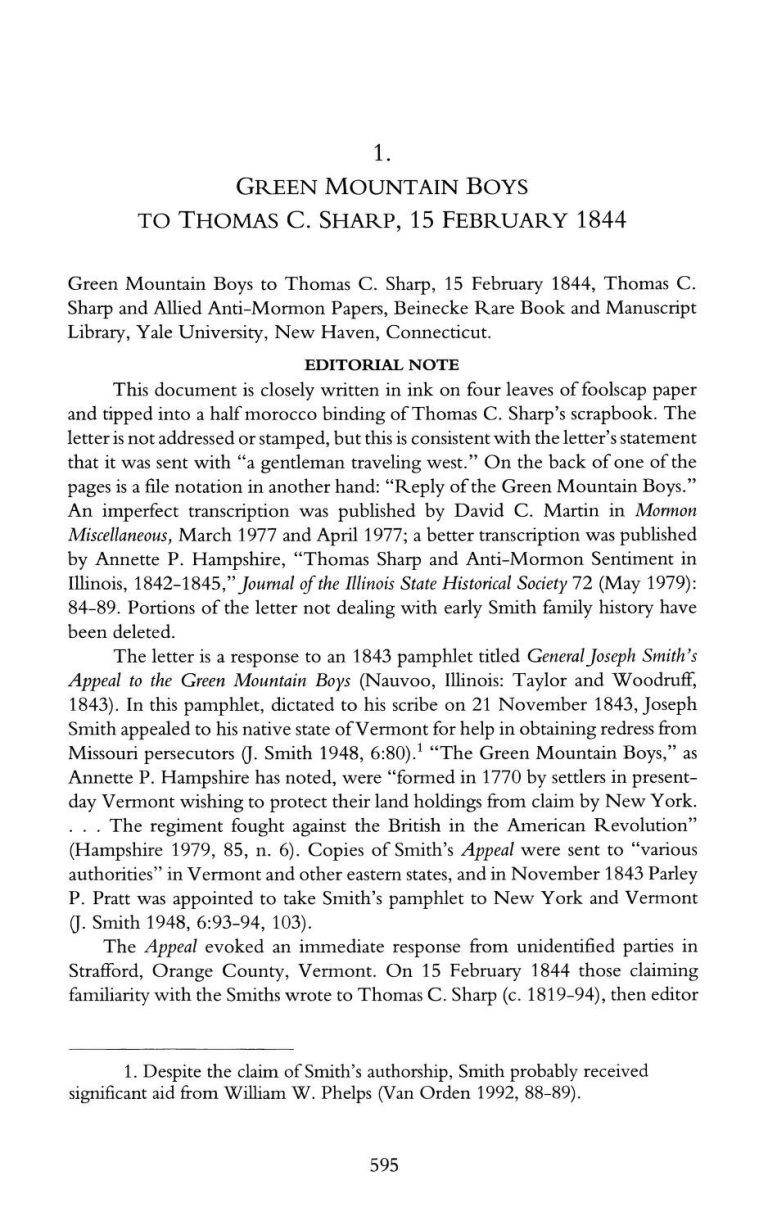

Pomeroy Tucker
1867
Pomeroy Tucker who was a resident in Palmyra and claimed firsthand knowledge of the Smiths said that:
“Joseph, moreover, as he grew in years, had learned to read comprehensively, in which qualification he was far in advance of his elder brother, and even of his father; and this talent was assiduously devoted, as he quitted or modified his idle habits, to the perusal of works of fiction and records of criminality, such for instance as would be classed with the “dime novels” of the present day. The stories of Stephen Burroughs and Captain Kidd, and the like, presented the highest charms for his expanding mental perceptions.”
[Pomeroy Tucker, Origin, Rise, and Progress of Mormonism: Biography of its Founders and History of its Church (New York: D. Appleton, 1867), 17; also cited in Dan Vogel’s Early Mormon Documents 3:94]
Orrin Porter Rockwell
November 1872
In November 1872, Elizabeth Kane interviewed Orrin Porter Rockwell who was a schoolmate and friend of the Smith’s.
“Not only was there religious excitement, but the phantom treasure of Captain Kidd were sought for far and near, and even in places like Cumorah.”


Philetus B. Spear
1873
Philetus was born in Palmyra in 1811 and evidently had first-hand knowledge of the Smith’s and their treasure hunting. He told his history to a student of his named Rev. J. S. Nasmith “nearly fifty years ago” (placing the account sometime around 1873).
“[Joseph] had for a library a copy of the “Arabia Nights,” stories of Captain Kidd, and a few novels… [Joseph] claimed to know where Captain Kidd had hidden money in Palmyra.”
[Philetus B. Spear’s recollections of c. 1873 are reported in he Marion Enterprise (Newark, N. Y.) September 29, 1923, 43:1, Dan Vogel, Early Mormon Documents, 3:130]
“No one could find it unless digging in the night. When they came near the devil would frighten them away. They must never mind him but dig on, or he would drag the treasure down deeper.
The men worked hard and long but saw no signs of gold, when Mr. Ellsworth, growing convinced of his folly, determined to play a joke upon his comrades. Going to the hill before the others, he scattered a train of powder around. About midnight, when the men were thinking of the signs that might come any moment, Ellsworth dropped his pipe on the powder. As it flashed, he shouted: ‘The Devil is coming! The Devil is coming!’ when one and all ran for dear life.”
[Philetus B. Spear’s recollections of c. 1873 are reported in he Marion Enterprise (Newark, N. Y.) September 29, 1923, 43:1, Dan Vogel, Early Mormon Documents, 3:130]

John Ahmanson
1876
Early Danish convert John Ahmanson, reported that “Joseph Smith found his [plates] while he was digging for treasure which was supposed to have been buried by the notorious buccaneer Captain Kidd in the western part of New York State.”
W. D. Purple
1877
William D. Purple was a physician who moved to South Bainbridge, New York about 1824. He claims to have attended Joseph Smith’s 1826 court hearing and to have kept notes at Justice Albert Neely’s request. He would have had first-hand knowledge of the Smith dealings.
“About this time [1825] he [Joseph Smith, Jr.] took upon himself a monomaniacal impression to seek for hidden treasures which he believed were buried in the earth. He hired help and repaired to Northern Pennsylvania, in the vicinity of Lanesboro, to prosecute his search for untold wealth which he believed to be buried there.
Whether it was the “Ninety bars of gold/ And dollars many fold” that Capt. Robert Kidd, the pirate of a preceding century, had despoiled the commerce of the world, we are not able to say, but that he took his help and provisions from home, and camped out on the black hills of that region for weeks at a time, was freely admitted by himself and family.
[W. D. Purple, “Joseph Smith, The Originator of Mormonism. Historical Reminiscences of the Town of Afton,” Chenango Union, May 3, 1877; also cited in Dan Vogel, Early Mormon Documents, 4:129-1309]

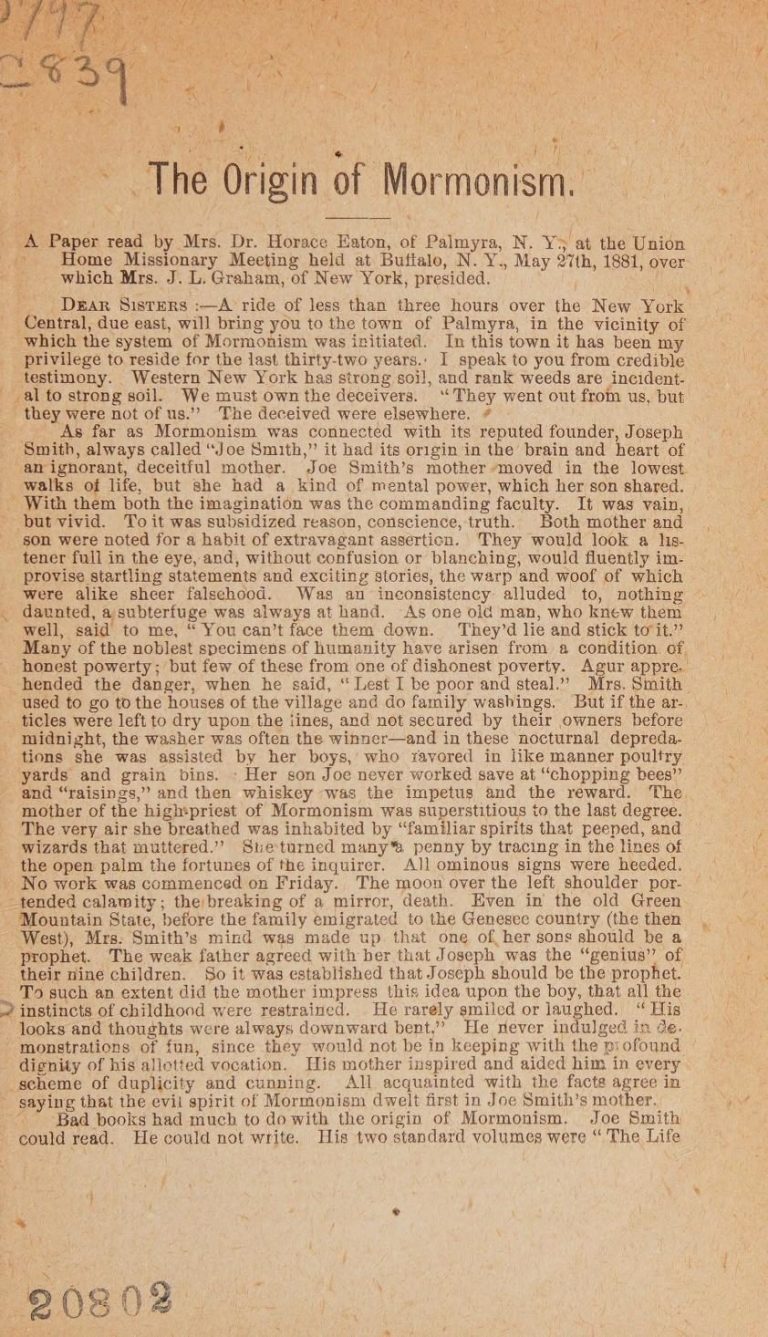
Anna Ruth Eaton
1881
Anna and her husband, Rev. Horace Eaton, moved to Palmyra in 1849 and so she had to rely on the testimony of others for her stories about the Smiths.
“Joe Smith could read. He could not write. His two standard volumes were “The Life of Stephen Burroughs,” the clerical scoundrel, and the autobiography of Capt. Kidd, the pirate. This latter work was eagerly and often perused. There was a fascination to him in the charmed lines:
“My name was Robert Kidd,
As I sailed, as I sailed;
And most wickedly I did
As I sailed, as I sailed.”
[Ann Ruth Eaton, The Origin of Mormonism (Women’s Executive Committee of Home Missions, 1881), 4; also cited in Dan Vogel’s Early Mormon Documents, 3:148-149]
Anna Ruth Eaton
1881
“At the early age of fifteen, while watching his father digging a well, Joe espied a stone of curious shape. It must have borne resemblance to the stone foot of Budha, which Mrs. House tells us of, at Bankok, Siam. All the difference, this was smaller, like a child’s foot. At any rate, it has left footprints on the sands of time. “This little stone was the acorn of the Mormon oak.” This was the famous Palmyra “‘seer”’ or ‘peek stone,” with which Joseph Smith did most certainly divine. Being before instructed by his mother, he immediately set up a claim to miraculous power. In a kneeling posture, with a bandage over his eyes, so luminous was the sight without it, with the stone in a large, white stove-pipe hat, and this hat in front of his face, —he saw things unutterably wonderful. He could reveal, full too well, the place where stolen property or wandering flocks could be found. Caskets of gold stored away by the Spaniards, or by his hero, the redoubtable Captain Kidd, coffers of gems, oriental treasures, the “wealth of Ormus and of Ind,” gleamed beneath the ground in adjacent fields and woodlands.

“Digging became the order of the night, and sleep that of the day. Father and brothers, decayed neighbors—all who could be hired with cider or strong drink—we organized into a digging phalanx. They sallied forth in the darkness. Solemn-ceremonies prefaced the work. Not a sod was disturbed by the spade till Joe’s mystic wand, the witch hazel, guided by the sacred stone, pointed out the golden somewhere. Entire silence was one condition of success. When hours had passed away, and the answering thud on the priceless chest was about to strike the ear, some one, in a rapture of expectancy, always broke the spell by speaking—the riches were spirited away to another quarter, and the digging must be resumed another night. Thus matters went on for seven or eight years. Little or no attention was paid to the performances of Smith near his home: Lovers of the marvelous from other towns now and then came in to see and hear something new. People from greater distances visited the several excavations and wondered. Newspapers heralded and ridiculed. But so far it amounted to nothing, unless it created a certain atmosphere heavy with myth and mystery, favorable to future developments.”
[Ann Ruth Eaton, The Origin of Mormonism (Women’s Executive Committee of Home Missions, 1881), 4; also cited in Dan Vogel’s Early Mormon Documents, 3:148-149]

Stephen S. Harding
1882
Stephen S. Harding was originally from Palmyra, New York. Harding evidently knew the Smith’s well and said that he had spent nights at the Smith home.
“When I left my home in the West, I had never heard of Mormonism, by that name. When I was a student at Brookville [Indiana], in the fall of 1827, the Brookville Enquirer was laid upon my table, when my eye fell upon a paragraph, credited to some Eastern paper, of the finding of a book of metallic plates, called the “Golden Bible. It was found by a young man by the name of Joe Smith, who had spent his time for several years in telling fortunes and digging for hidden treasures, and especially for pots and iron chests of money, supposed to have been buried by Captain Kidd. This paragraph interested me more at the time from the fact that all this had happened near the village of Palmyra, N.Y. I had at the time no certain recollection as to who this “Joe Smith” was; but remembered having seen a long-legged, tow-headed boy of that name, who was generally fishing in the mill-pond at Durfee’s grist-mill, on Mud Creek, when my elder brother and I went to miU. This boy was about three years older than myself, and it turned out that he was the veritable finder of the “Golden Bible.”
[Dictated letter of Stephen S. Harding to Thomas Gregg, February 1882, in Thomas Gregg, The Prophet of Palmyra (New York: John B. Alden, 1890), 35; cited in Dan Vogel, Early Mormon Documents, 3:153-154]
Ellen E. Dickinson
1885
“It is said that joseph at an early age could read, but not write; and when quite young committed these lines to memory from the story of Captain Kidd the notorious pirate, which seemed to give him great pleasure:
“My name was Robert Kidd,
As I sailed, as I sailed;
And most wickedly I did
As I sailed, as I sailed.”
[Ellen E. Dickinson, New Light on Mormonism (New York: Funk and Wagnalls, 1885, 28-29]
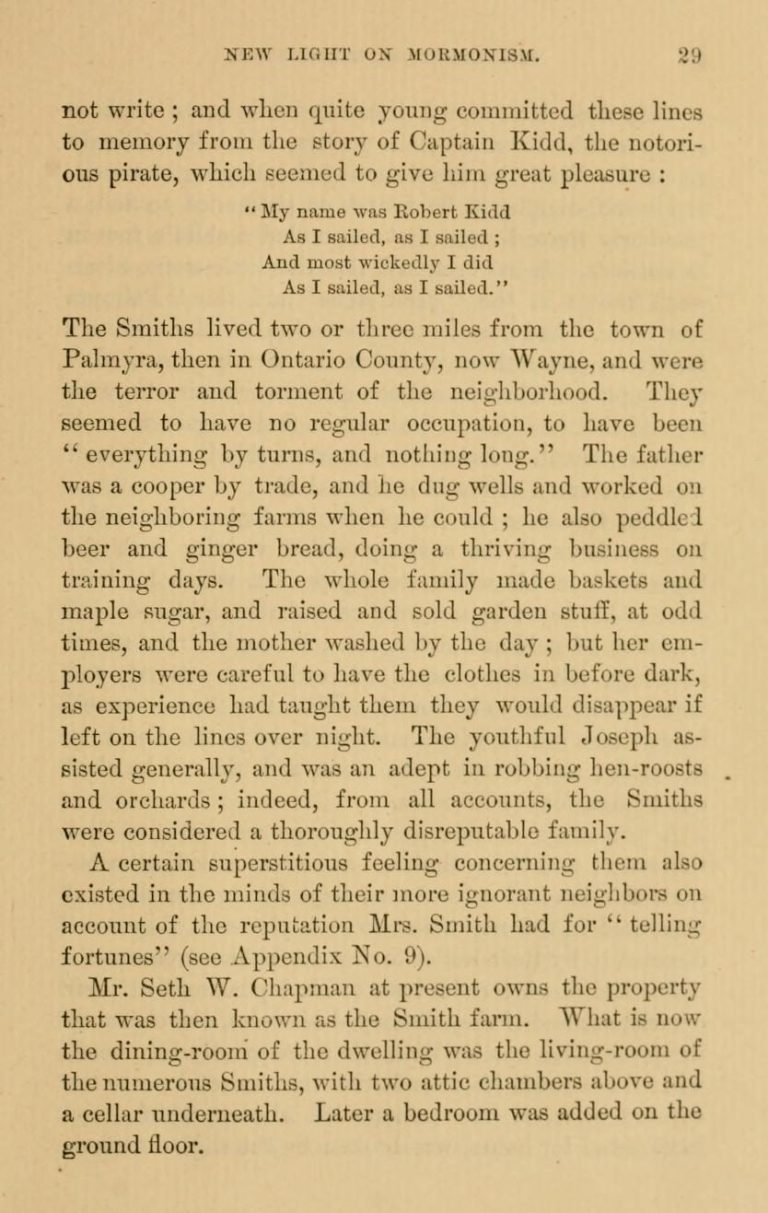
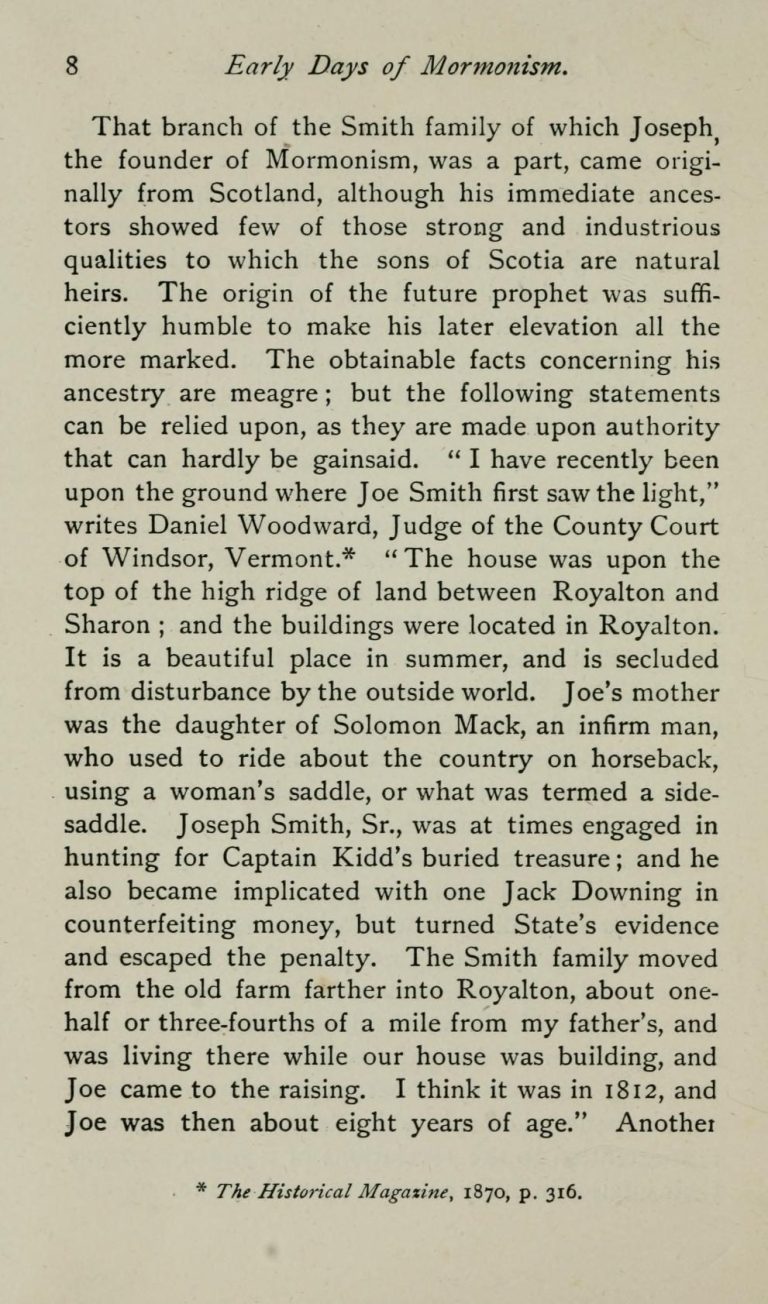
J. H. Kennedy
1888
J. H. Kennedy informs us that even before the Smith’s settled in western New York, “Joseph Smith, Sr., was at times engaged in hunting for Captain Kidd’s buried treasure” in Vermont.
J. H. Kennedy
1888
In speaking of Joseph Smith Jr. he said: “The boy’s education, or rather the rude smattering of learning that went by that name, was but added preparation for that which lay before him; he was not given to books, and the few he was persuaded to read were of vicious tendency, and set his imagination in the wrong direction. His favorites have been described as the “Life of Stephen Burroughs,” a scoundrel dressed in the garb of the church, and the autobiography of the pirate Kidd. Smith afterward made confession that the book last named made a deep impression upon him, and owned to a special fascination in these lines found therein:
“My name was Robert Kidd,
As I sailed, as I sailed;
And most wickedly I did,
God’s laws I did forbid,
As I sailed, as I sailed.”


J. H. Kennedy
1888
“With a bandage over his eyes he would fall upon his knees and bury his face in the depths of an old white hat, where the stone was already hidden. Out of these oracular depths he would tell his gaping audience where the treasures of Kidd and others lay concealed; locate the trail of wandering flocks; point out the deposit of stolen goods; and perform other wonderful things which only those of that faith which asked no questions could believe.”
W. R. Hine
1888
William Riley Hine was a resident at Colesville, Windsor Township, New York, who claimed first-hand knowledge of the Smith family.
“Jo Smith claimed to be a seer. He had a very clear stone about the size and shape of a duck's egg, and claimed that he could see lost or hidden things through it. He [Joseph] saw Captain Kidd [the pirate] sailing on the Susquehanna River during a freshet, and that he buried two pots of gold and silver. He claimed he saw writing cut on the rocks in an unknown language telling where Kidd buried it, and he translated it through his peepstone. I have had it many times and could see in it whatever I imagined. Jo claimed it was found in digging a well in Palmyra, N.Y. He said he borrowed it. … Joe dug for Kidd’s money, on the west bank of the Susquehanna, half a mile from the river”
[Statement of W. R. Hine in Deming, Naked Truths About Mormonism, 1 (January 1888):2]
NOTE: A freshet is the flood of a river from heavy rain or melted snow


K. E. Belle
1888 (1885)
K. E. Belle was a resident of Harpersfield, Delaware County, New York. He claimed to have attended “the first Mormon meeting Pratt and Cowdery held in Painesville.” His brother Milo evidently knew the Smith’s personally.
“My brother Milo, from Broome County, N.Y., was present. They told about Prophet Jo Smith finding the gold plates, and said they saw them. My brother ridiculed them after the meeting. He told me he knew Jo Smith when he was digging near the Susquehanna River for Captain Kidd's money. Jo had a peep-stone through which he claimed to see hidden or buried treasures. Jo sold shares to all who would buy, and kept the money. He said they would all make a circle, and Jo Smith claimed if they threw any dirt over the circle the money chest would leave. They never found any money.
[Statement of K. E. Belle in Deming, Naked Truths About Mormonism, 1 (January 1888):2]
Thomas Gregg
1890
In his book The Prophet of Palmyra, Thomas Gregg gives the following account of what he has learned concerning Joseph Smith:
“We find him [Joseph Smith, Jr.] at an early age, trying his skill at little tricks to impose on the credulity of his ignorant associates. As he grew in years, searching for lost treasure became one of his favorite employments; for was it not better, he reasoned, to obtain the golden thousands from the nooks and crevices of the earth, where Captain Kidd and the pirates and robbers had secreted them, and live in ease and idleness, than to obtain a small competency by the slow and uncertain processes of honest labor? And thus he plodded on, till accident opened a new career for him.”
In his book he also published a letter written in 1882, by one Stephen S. Harding…
[Thomas Gregg, The Prophet of Palmyra (New York: John B. Alden, 1890), 5]
